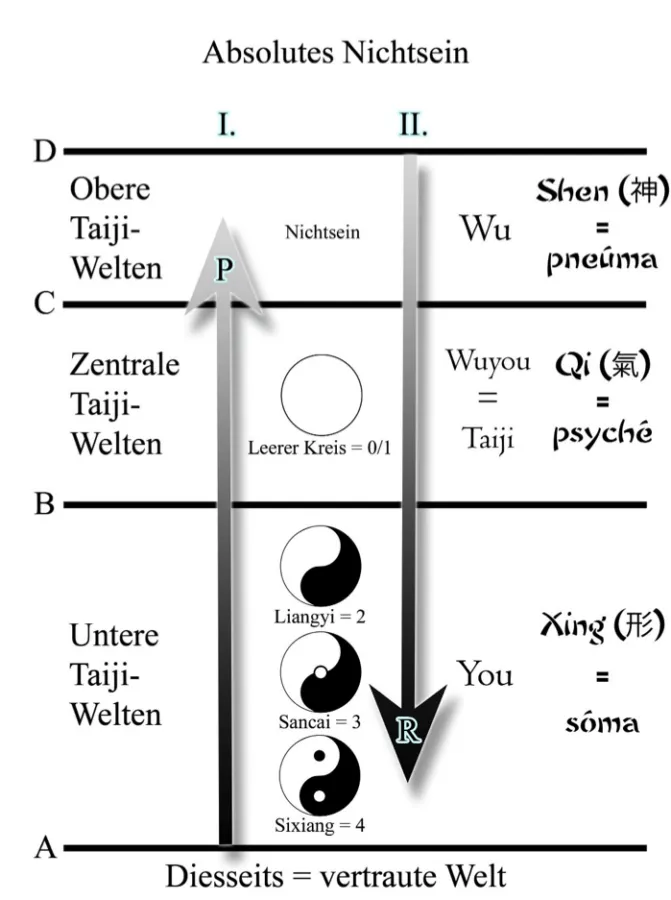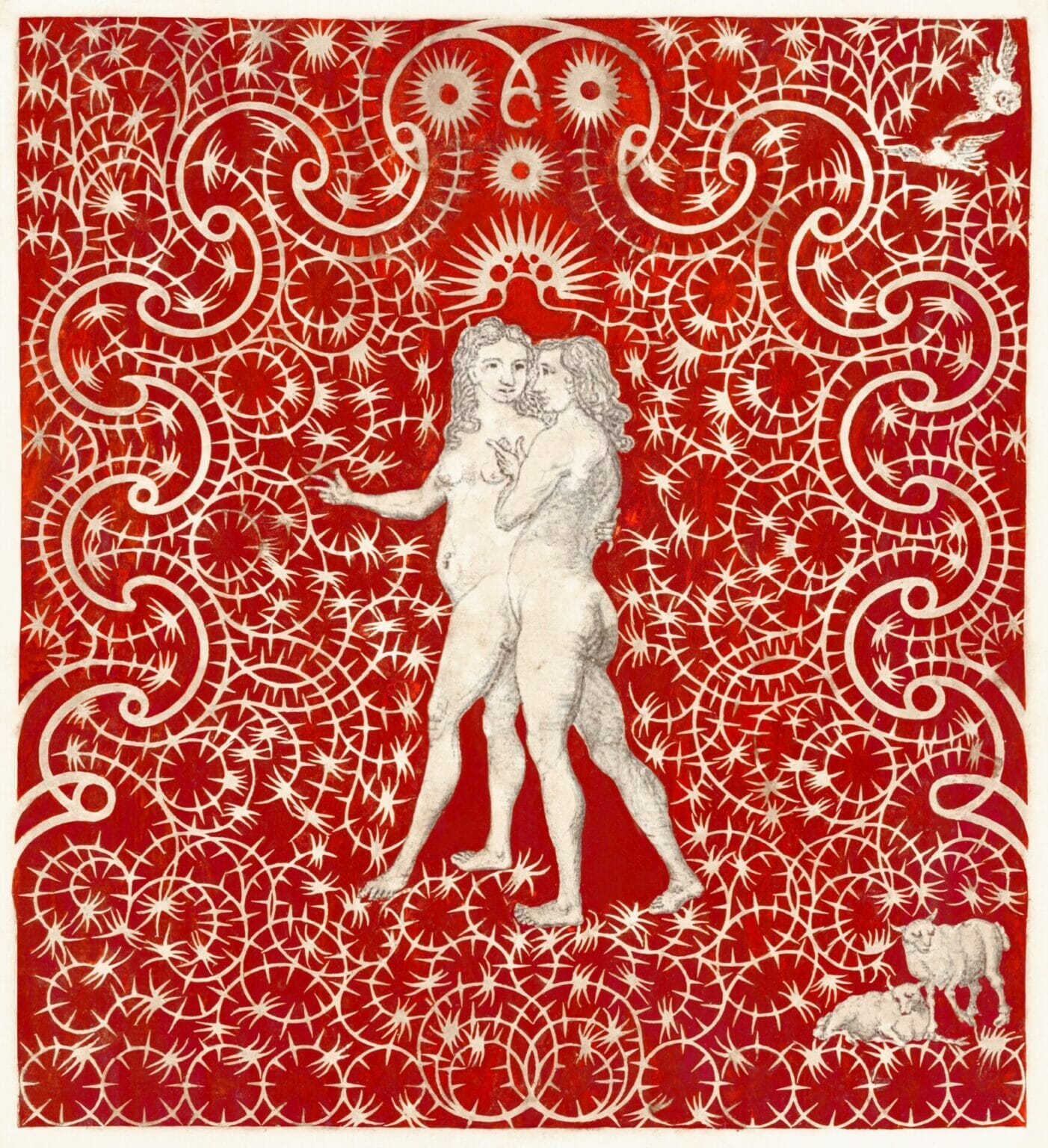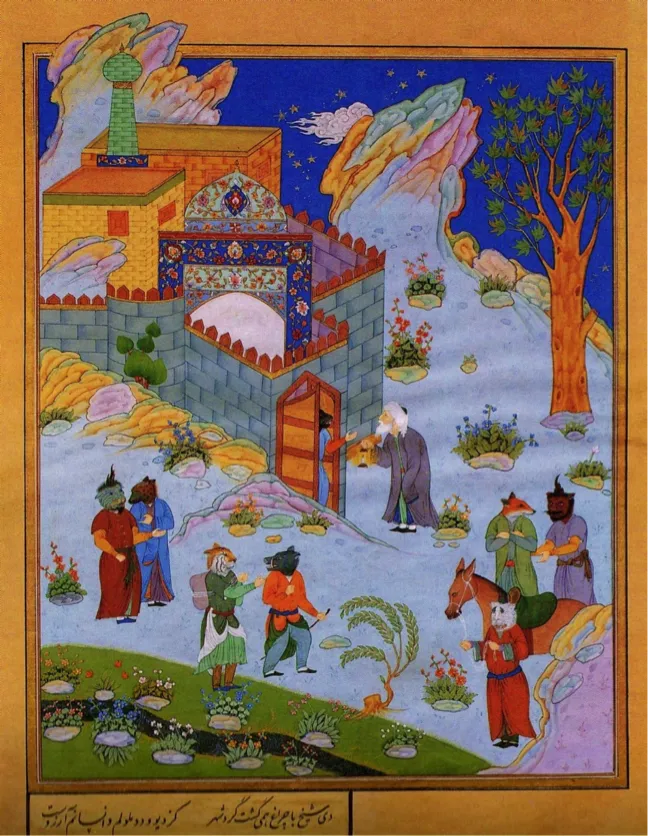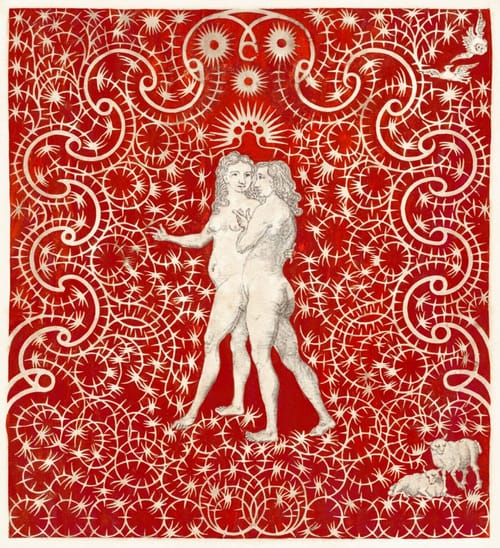Two souls, dwell alas! In my breast
Wolfgang von Goethe writes in Dr. Faustus: “Two souls, dwell alas! In my breast. One wants to separate from the other.” But did he know that since time immemorial, Masters from the East and West have experienced the essence of his words “with body and soul (image 1)” and taught the knowledge they gained in this way? Was he familiar with the fact that sóma (anima) and pneúma (animus) interact in ascending and descending in order, as he writes, to separate?
This was known to Suhrawardi (see DGUE), who inspired[1]. the Iranian poet Hafez (c. 1320-1390) and who in turn inspired Goethe. If Goethe had known, he would certainly have shared what I am sharing with readers in my interpretation of the following two myths, which are very similar to the AEM I describe in detail in DGUE.
Etymology of Adam and Eve
With (psyché =) sóma, the world of this world is understood as the “created world of diversity (pánta) spread out before us”. This is the dualism of this world, the lowest world (A in Figure 2), in which each concept (e.g. man, friend, good, multiply, etc.) is recognized by separating it from what it is not. This consists of pairings (man-woman, friend-enemy, good-bad, multiply-reduce, etc.) that exist (live) together.

The etymology of Eve points to this. Eve derives from the Hebrew verb חוה (hawa): to spread out in order to exist[2] together (mated). Adam is derived from דמם (dmm), to begin, to produce.[3] This is a reference to the origin of creation (D in Figure 2), i.e. to the (monistic) ONE (hèn) or pneúma that is experienced more and more in the ascension (arrow I). This recognizes the act (arrow II) that produces (generates) everything (below D), including the worldly paired multiplicity (A = pánta), out of nothing (D) (creatio ex nihilo).
This is addressed in: THE heaven (ouranós) produces THE earth (gaía). Likewise in: Adam generates his counterpart Eve! This is referred to in Genesis (chapters 2-5): “Thereupon God caused Adam to fall into a deep sleep, took from him a rib (literally, “side”), and from it created his counterpart Eve.”
Adam and Eve thus allegorize the uppermost and lowermost perception of the highest reality (below D) that can be experienced super sensually during enlightenment in deep stillness (“sleep”): Dao = Lógos. Philon calls it kosmos noétos and distinguishes it from being (this world), which he calls kosmos aisthetos (see DGUE).
Consequences of the ignorance of Adam and Eve
What is assigned to Adam-Eve also concerns the following two myths that I have uncovered. These suggest a patriarchal attitude on the part of their authors, which is also evident in:
Ephesians (5:22): Let women be subject to their husbands […].
Ephesians (5:23): For the husband is the head of the wife […].
Both and similar statements contributed to the devaluation of women and the promotion of men in Abrahamic religions. This includes further quotations in which the act (Arrow II) is called “Fall of Man” and “Expulsion from Paradise” and Eve is held responsible for it.
One of the dramatic consequences of devaluing women was the persecution of witches. One of the first alleged witches was Hypatia (355-415/416), Master of the philosophía in Alexandria, who was murdered by a Christian mob and her body dismembered (see DGUE).
Origin of the myths
The origin of the following two myths and that of many myths coherent with them (see DGUE), like qi (psyché) knowledge, probably goes back to shamanic times. This was an age in which the personal experience of creation was more important to OBEDIENT philosophoí (theologoí) (Fig. 1) – thanks to the rise of the psyché (Arrow I) – than the socially shaped belief in the ONE (hèn) or a Creator God that arose from it. The reason is because regular practice serves not only self-knowledge (Arrow I) but also the healing of diseases.
Since the Ascension purifies the sensory limited perception of this world, e.g. by revealing the “poetry art” about it, Laozi recommends indulging in both ways (A and Arrow II) (ch.48): “He who strives for knowledge (in A) should multiply every day. He who strives for the Dao (Arrow II) must diminish (in practice) every day.” This is also recommended (see DGUE) by other masters to whom asceticism (withdrawal from the world) is unknown.
The Lógos behind the myth
The first of the two myths that follow is from ancient Greek mythology, the second is quoted by Ibn Sina (Avicenna, 980-1037). Before presenting both, I would like to mention that they, like many others, only appear to us as myths (“poetry”) because we do not appreciate their metaphorical content, which is experienced more and more in the ascent.
This is especially true of complacent interpreters who claim that the authors of the myths gave themselves over to myth, while they, although they do not know how to reveal the lógos behind it, consider themselves logical (rational) thinkers (see TV 45).

Explanation of the myths
The myths’ contents can be explained to a certain extent to the untrained, which is what I try to do. I do this by drawing on my Dao knowledge imparted by Dao Master Fangfu and in part acquired through practice. If accepted, the myths reveal the buried unique universal truth (aletheía) that lies behind them.
They allow successful practitioners (Figure 1) to recognize the lógos (TV 45), which they cannot question. This, and not the word with which lógos is often and in the New Testament exclusively translated, sheds light on what the pairings female (woman)-male (man), Eve-Adam and anima (female soul)-animus (male soul) originally meant. It confirms to them that in the ascent (arrow I), “in the struggle with oneself (image 1)”, anima (Eve) is defeated by animus (Adam). In the descent (arrow II) it is the other way round. Here are both myths.
Heracles and Kakia
According to Xenophon (c. 430-354 BCE), Kakia[4] bewitched Heracles, the “Son of Zeus”, with: “You shall have the (this side, earthly) fruits of others’ toil, and refrain from nothing that can bring you gain. For to my companions I give authority to pluck advantage where they will” When Heracles heard this, he asked Kakia, “Lady, please tell me your name?” “My friends call me Luck,” she said, “but among those who hate me, my name is Kakia.” Heracles managed to turn away from her and towards the virtue (arété) that ascension (Arrow I) – his “becoming male” – enabled him to achieve.

Salman und Absal
Salman (Salaman)[5] was raised by Absal, a young attractive wet nurse, with whom he fell in love as a youngster. His father (ruler; king) repeatedly asked him to leave Absal. The latter tried to make it clear to Salman that he could not ascend (arrow I) to the throne of his kingdom (this is a reference to D in Figure 2) and at the same time be intimately attracted to Absal (this is a reference to A in Figure 2), since either the (heavenly) kingdom (in D) or she (in A) would take him.
Absal was aware of her attractiveness and appeal. She advised Salman to ignore his father (inner ruler in D): “I am a woman who delights your soul (psyché = sóma). But you are not one who can easily leave me, but I am someone who could.” Here comes a brief explanation of the myth, which I will elaborate on after the following myth.
Salman, the “King’s son”[6] freed himself from Absal by increasing (psyché =) pneúma in ascent and decreasing (psyché =) sóma. This is anything but easy, since for practitioners it is a rule (Matthew 26:41): “The spirit (pneúma) is willing, but the flesh (sarx = sóma) is weak.” Salman nevertheless found his way (to D) to “(inner peaceful) kingship”.
This requires masterly support, which Noah (TV 90) offered to his “male-female paired animals” as well. He led them to the “other shore (D)”, so that there they UNITED again. This also applies to the “animal people” in picture 3, which I will come back to.
Interpretation of both myths
The Dao teachings show me that the sages cited and many others, including the masters Diotima (in Plato’s Symposium), Rabia of Basra (718-801) and Hypatia, put their acquired knowledge through the EXERCISE of philosophía (epistéme) into metaphors, just as Fangfu did. These include the pairings Salman-Absal and Heracles-Kakia, as well as father, throne, empire, Zeus, king’s son and kingship. Their allegorical contents, which can be experienced in the ascent (arrow I), are revealed through the activation of the pneúma with masterful help, whereby the sóma is diminished.
This leads successful practitioners to enlightenment (in D), which Salman and Heracles attained. With this they realized: “The act of creation (arrow II), the expulsion from paradise (D), results from the fact that the human race evolved in the course of its civilization by following the ‘seductive lure of Eve’.” This implies that it turned away from the hypothesis-free aletheía (truth) experienced in the Ascension and towards the hypothesis-based dóxa (to mean, to believe, to hold true) on this side.
Both myths, as well as the coherent AEM discussed in detail in the DGUE, do not reveal what is necessary to understand them without an explanation of (sóma, psyché, pneúma). Their interpretation without knowledge of the profound content of the triplet does not lead out but into Plato’s “cave”, an allegory for this world (A).
This is part II of “Adam and Eve”. Part III you can find here.
Part I you can find here.
Translated from German to English from Lynn Taylor.
Selected publications of Prof. Dr. Peter Hubral
»The Tao: Modern Pathway to Ancient Wisdom«, in: Philosopher 98, Nr. 1, 2010
The Lao Tzu Code: Key to ancient Chinese and Greek natural life care and search for truth
[1] IRAN-READER 2017, CONTRIBUTIONS TO THE GERMAN-IRANIAN CULTURAL DIALOGUE, Compiled by Oliver Ernst; Konrad-Adenauer-Stiftung e.V. 2017, Sankt Augustin/Berlin
[2] www.abarim-publications.com/Meaning/Eve.html
[3] www.abarim-publications.com/Meaning/Adam.html
[4] Kakia (Gr.) means bad when translated directly. https://en.wikipedia.org/wiki/Kakia.
[5] Salman, like Solomon, refers to: “being whole or complete”, as is the case at the end (D) of the ascent (arrow I). Vgl. www.abarim-publications.com/Meaning/Solomon.html
[6] Siehe: www.sacred-texts.com/isl/saab/index.htm und www.sufi.ir/books/download/english/jami-en/salman-absal-jami-en.pdf
